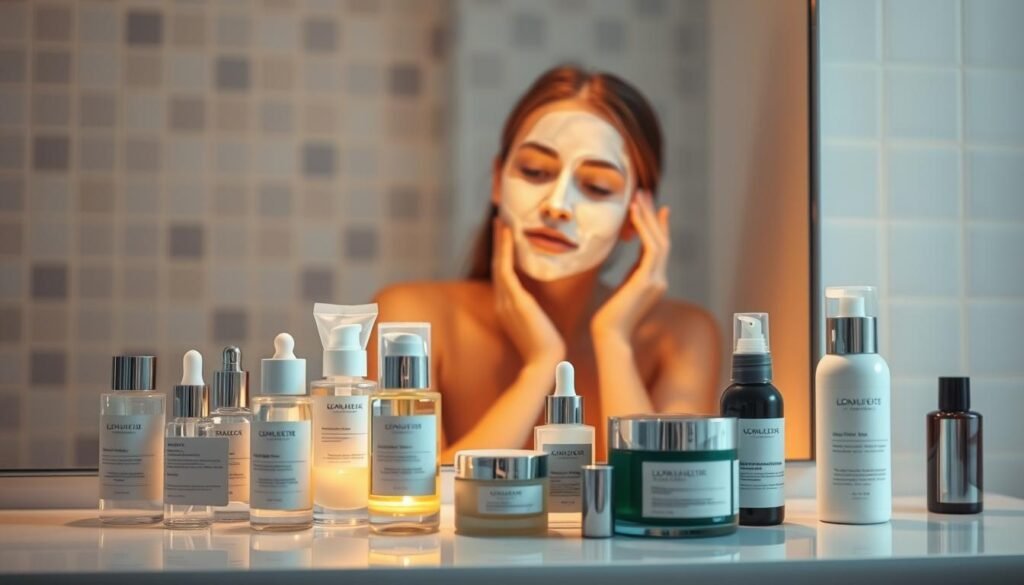What if everything you know about achieving radiant skin is wrong? Many assume flawless complexions come from pricey creams or quick fixes. But true luminosity starts with understanding your body’s natural rhythms and nurturing it holistically.
Healthy, vibrant results aren’t about shortcuts. They’re built through daily habits that support your body inside and out. Think fresh foods, quality sleep, and science-backed products that work with your unique needs. Even small tweaks—like adding vitamin-rich ingredients to meals—can create visible changes over time.
This guide cuts through the noise. You’ll learn how professionals balance immediate glow-boosters with lasting strategies. From gentle exfoliation techniques to stress-reducing routines, we break down what actually delivers results. No magic potions—just practical steps anyone can follow.
Key Takeaways
- Consistent routines matter more than expensive products
- Nutrition and sleep directly impact your face’s appearance
- Vitamin C and retinol are proven allies for brightness
- Quick fixes work best when paired with long-term care
- Custom approaches beat generic solutions every time
Understanding Healthy Skin & Radiance
Ever wonder why some people seem to have that effortless luminosity? True radiance isn’t about masking flaws—it’s about creating optimal conditions for your body’s largest organ to thrive.

What Makes Skin Glow?
Your complexion’s radiance comes from three main factors. First, cell turnover—the process where fresh cells replace old ones—keeps surfaces smooth. Second, balanced hydration ensures tissues stay plump and reflective. Third, a strong barrier locks in nutrients while blocking pollutants.
Think of it like a well-maintained window: when clean and intact, light bounces off beautifully. Damaged or parched surfaces scatter light unevenly, creating dullness.
The Role of Hydration & Nutrition
Water intake acts like an internal moisturizer. Cells swell slightly when hydrated, smoothing fine lines and boosting light reflection. Pair this with foods rich in vitamin C (like oranges) and omega-3s (like walnuts) to fuel collagen production.
Here’s what matters most:
- 8 glasses of water daily for moisture retention
- Leafy greens for antioxidant protection
- 30-minute walks to enhance nutrient delivery
Small changes create big shifts. Swap sugary snacks for berries, or add cucumber slices to your water bottle. Your face reflects these choices within weeks.
Glowing Skin Secrets: Essential Daily Habits
Did you know your daily habits hold the key to unlocking your complexion’s true potential? Consistency in care creates lasting results, whether you’re prepping for sunrise or winding down at night. Let’s explore how simple adjustments to your schedule can amplify your natural vitality.

Morning Routine Essentials
Start with a gentle cleanser to remove overnight oil without stripping moisture. Follow with a vitamin C serum—it brightens while shielding against pollution. Always apply SPF 30+ sunscreen, even on cloudy days. This trio takes under 5 minutes but protects all day.
Evening Regimen Tips
Nighttime is repair time. Use micellar water to dissolve makeup, then a cream-based cleanser. Apply retinol or hyaluronic acid 20 minutes after drying—damp skin absorbs actives better. Finish with a ceramide-rich moisturizer to lock in hydration.
| Focus | Morning | Evening |
|---|---|---|
| Primary Goal | Protection | Recovery |
| Key Steps | Cleanse → Antioxidant → SPF | Double Cleanse → Actives → Moisturize |
| Product Types | Lightweight formulas | Rich textures |
Wash your face at three critical moments: upon waking, after sweating, and before bed. Over-cleaning disrupts pH balance—stick to lukewarm water and pat-dry techniques. Remember: consistency trumps complexity. A basic routine done daily beats elaborate treatments used sporadically.
Building a Simple Cleansing Routine
Your daily cleanse does more than just wash away dirt—it sets the stage for your complexion’s health. A thoughtful approach removes impurities while protecting your natural moisture barrier. Let’s break down how to create a regimen that works smarter, not harder.
Cleanser Selection Made Simple
Not all cleansers work for every face. Dry types thrive with cream-based formulas, while oily complexions benefit from gel textures. pH-balanced options (5.5-6.5) maintain your protective acid mantle better than traditional soaps.
| Type | Best For | Key Ingredients |
|---|---|---|
| Oil-Based | Makeup Removal | Jojoba Oil, Squalane |
| Water-Based | Sensitive Skin | Ceramides, Oat Extract |
| Exfoliating | Rough Texture | Lactic Acid, Bamboo |
Professionals recommend the double-cleanse method: start with an oil product to dissolve sunscreen, then follow with a water-based formula. Use lukewarm water—hot temperatures strip natural oils, while cold won’t lift grime effectively.
Massage products in upward circles for 60 seconds. This boosts circulation and ensures thorough coverage. Pat dry with a clean towel instead of rubbing to prevent irritation. Time your sessions after workouts and before bed for optimal results.
Moisturizing for Radiance: Unlocking Healthy Skin
Did you know that even the best cleanser needs a perfect partner? Your moisturizer isn’t just an afterthought—it’s the seal that locks in your efforts. The Academy of American Dermatology confirms: applying it to damp faces post-cleanse traps moisture 30% more effectively than dry application.

Oily types often skip this step, but that backfires. Lightweight, non-comedogenic formulas hydrate without clogging pores. Dry complexions thrive with richer textures containing shea butter or squalane. Combination faces? Try layering—gel on T-zones, cream elsewhere.
Your barrier function acts like a security system. When intact, it keeps hydration in and irritants out. Look for ceramides and fatty acids in products—they’re like mortar between your skin’s brick-like cells. Hyaluronic acid works overtime, holding 1,000 times its weight in water.
Pro tip: Warm a pea-sized amount between palms before pressing onto cheeks. This technique boosts absorption better than rubbing. Nighttime? Mix in two drops of jojoba oil for extra nourishment while you sleep.
The Importance of Sunscreen & UV Protection
How often do you skip sunscreen when working indoors? Sun damage doesn’t take vacations—it accumulates through car windows, office buildings, and cloudy skies. New York dermatologist Doris Day confirms: “Ninety percent of wrinkles come from sun exposure. Prevention beats repair every time.”
Broad Spectrum Benefits
Not all sunscreens work equally. Broad-spectrum formulas tackle both UVA rays (cause aging) and UVB rays (cause burns). Here’s why this matters:
| Ray Type | Effect | Protection Method |
|---|---|---|
| UVA | Penetrates glass, causes wrinkles | Look for “broad spectrum” label |
| UVB | Burns surface, triggers skin cancer | SPF 30+ blocks 97% rays |
Apply a nickel-sized amount every morning—even on rainy days. Neck and ears often get missed. Reapply every two hours outdoors. For office workers? Morning application still works since UVA rays stay constant through windows.
Choose mineral options with zinc oxide if sensitive to chemicals. These sit on top of skin instead of absorbing. Pair with antioxidants like vitamin E for extra defense against free radicals.
At-Home Natural Remedies for Glowing Skin
Your kitchen holds more beauty potential than you think. Everyday ingredients can become powerful allies in your self-care routine. Let’s explore safe, effective ways to boost your complexion using items you already own.
Utilizing Kitchen & Pantry Staples
Honey works like nature’s moisture magnet. Spread a thin layer on clean faces for 10 minutes to soften texture. Mashed raspberries mixed with yogurt create a brightening mask—their ellagic acid fights environmental damage. Oatmeal blended with water calms redness instantly.
Coconut Oil and Aloe Vera Insights
This tropical oil dissolves makeup gently but requires caution. Test it behind your ear first—some find it clogs pores. Fresh aloe gel cools irritation while boosting cell renewal. Apply after sun exposure or shaving for quick healing.
Always do patch tests with new ingredients. Wait 24 hours before full-face use. Remember: natural doesn’t mean risk-free. Balance DIY treatments with professional advice for lasting results.
Exfoliation Techniques for a Smooth Complexion
Revealing your brightest self starts with smart exfoliation. Unlike harsh scrubs that scratch surfaces, chemical exfoliants dissolve dead cells gently. These products work like invisible helpers—breaking bonds between dull layers without physical friction.
Beta-hydroxy acids (BHAs) penetrate pores deeply. Salicylic acid clears debris while calming inflammation. Apply after cleansing 2-3 weekly for best results. Always follow with SPF—these formulas increase sun sensitivity.
Timing matters. Use treatments at night to avoid daytime UV damage. Wait 15 minutes post-application before adding serums. Darker tones should test formulas first—some acids may cause discoloration.
Choose pH-balanced options (3-4) for effectiveness. Pair with hydrating creams to prevent dryness. Remember: less is more. Overuse weakens your barrier, leading to redness.



